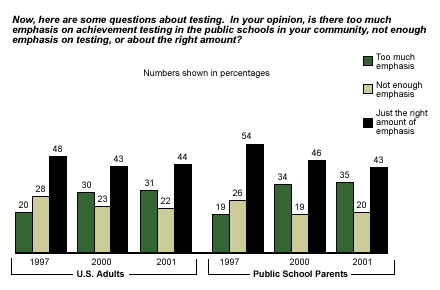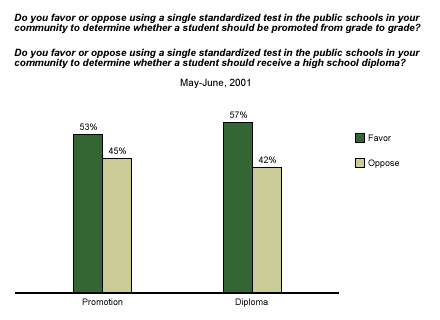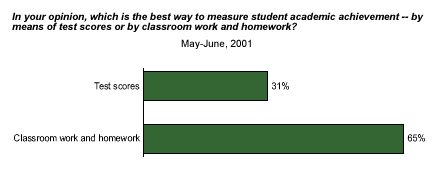In January, President Bush signed into law the No Child Left Behind Act, which makes once-voluntary achievement standards and testing measures mandatory in each state. Among other things, the new law requires state education departments to establish specific achievement standards for children in grades three through eight, and to annually test students for achievement of those standards. Throughout the country, standardized test scores are gaining more influence on state decisions in such high-stakes areas as school funding and staffing, and criteria for promoting students to the next grade.

The issue of testing has been explored three times over the past five years (in 1997, 2000 and 2001) in the Phi Delta Kappa/Gallup education poll*. Results show that Americans have mixed feelings on the subject. The percentage of Americans who believe that standardized testing is overemphasized in public schools has increased significantly since 1997. Americans also believe that student achievement is better measured through classroom work and homework than it is through testing. But a majority of U.S. adults feel that standardized tests should play a role in promoting students from grade to grade and awarding high school diplomas.
Resistance to the increased use of tests went up significantly between 1997 and 2000 (see graph above). The percentage of Americans who believe there is too much emphasis on testing rose from 20% in 1997 to 30% in 2000, and the percentage of those who believe that there is not enough emphasis dropped from 28% in 1997 to 23% in 2000. Changes between 2000 and 2001 were generally insignificant, except for among non-whites; the percentage of non-whites who believe that there is too much emphasis on testing increased from 27% in 2000 to 42% in 2001.
Two questions introduced in 2001 sought to determine the public's attitude toward the use of a single standardized test to determine grade-to-grade promotion and to decide whether a student should receive a high school diploma. Majorities of the public support each practice, with 53% favoring use of a test in grade-to-grade promotion and 57% in the decision to grant a diploma (see graph below).

Two questions asked for the first time in 2000 and repeated in 2001 explored, in broader terms, public opinion about the way tests should be used and the way student achievement should be measured.
The first question asked respondents to indicate whether tests should be used to determine how much students have learned or to determine the type of instruction needed. In both 2000 and 2001, two-thirds of respondents (65% in 2000, 66% in 2001) indicated that tests should be used to drive instruction (see table below). Non-whites (77%) and those between the ages of 18 and 29 (79%) believe even more strongly that test use should be related to instruction. Political affiliation also comes into play, with 40% of Republicans but only 25% of Democrats believing that tests should be used to judge student learning.
|
National Totals |
No Children in School |
Public School Parents |
||||
|
2000 |
2001 |
2000 |
2001 |
2000 |
2001 |
|
|
Determine how much students have learned |
30% |
30% |
32% |
30% |
27% |
29% |
|
Determine the kind of instruction needed |
65% |
66% |
63% |
65% |
69% |
69% |
The second question asks respondents whether test scores or classroom work and homework are the best way to measure student achievement. Sixty-five percent (65%) come down on the side of classroom work and homework (see graph below). This percentage rises to 77% among those between the ages of 18 and 29.

Heather Mason contributed to this article.
*Based on telephone interviews with 1,108 adults, aged 18 and older, conducted May to June 2001. For results based on this sample, one can say with 95% confidence that the margin of sampling error is ±3%.